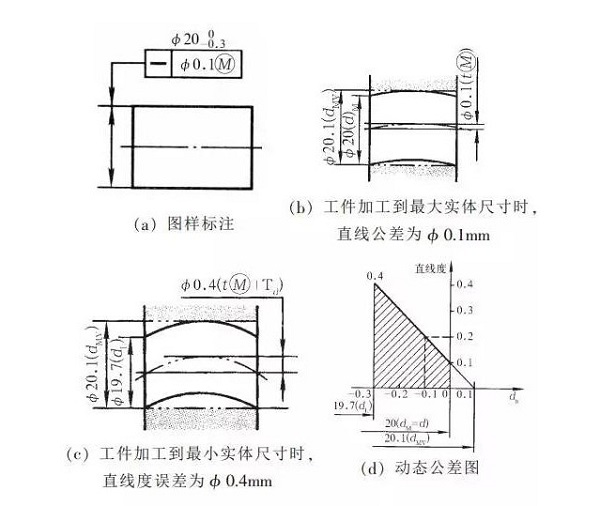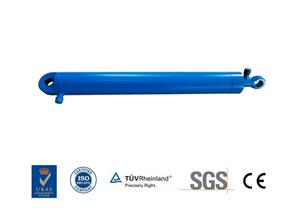Tolerance principle
Tolerance principle, independence principle, maximum entity, minimum entity, tolerance requirements
Maximum solid state: the actual element has the state with the most materials within the dimensional tolerance range;
Minimal solid state: the actual elements are within the dimensional tolerance range and have the least material state;
Maximum solid size: the size at the maximum solid state; the maximum solid size of the external surface (axis, boss, etc.) is equal to the maximum limit size, and the maximum solid size of the internal surface (holes, slots, etc.) is equal to the minimum limit size.
Minimum solid size: the size at the minimum solid state; the minimum solid size of the external surface (axis, boss, etc.) is equal to the minimum limit size, and the minimum solid size of the internal surface (holes, slots, etc.) is equal to the maximum limit size.
Maximum solid boundary: In the maximum solid state, a boundary with an ideal shape;
Minimum solid boundary: In the minimum solid state, a boundary with an ideal shape;
Effective state: The limit boundary formed by the maximum physical size of the measured element given on the drawing and the shape tolerance of the axis or center plane of the element, and the limit boundary should have an ideal shape;
Effective size: the boundary size in the actual state is the combined result of the maximum solid size and shape tolerance; for external surfaces (shafts, bosses, etc.), effective size = maximum limit size + shape tolerance, for internal surfaces (holes, slots, etc.), Effective size = minimum limit size-shape tolerance;
What is the tolerance principle?
The tolerance principle is a rule that deals with the relationship between dimensional tolerance and geometric tolerance. It specifies the principle of the relationship between dimensional (linear and angular) tolerance and geometric tolerance. National standard tolerance principles apply to technical drawings and related documents for dimensional, dimensional, and geometrical tolerances to constrain the size, shape, and location characteristics of component elements.
The tolerance principle is divided into the independent principle and related principles; the independent principle is better understood, and the related principles are further divided into tolerance requirements, maximum entity requirements (and their reversible requirements), minimum entity requirements (and their reversible requirements).
What is the principle of independence?
The principle of independence is that each size and geometry requirement (shape, direction, and position) given on the drawing is independent, and the requirements should be met separately, each controlling its own limit. Dimensional and geometrical tolerances that adhere to the principle of independence do not add any specific relationship symbols to the drawings. Most of our drawings use the principle of independence, because the principles of tolerance, the largest entity, and the smallest entity are indeed a bit complicated, and there are not many labels in this aspect of the work. Most suppliers do not understand these things too; of course, it does not mean that these things are useless. High-end, precision products must still consider these tolerance principles.
What are the relevant principles?
The related principle is that the given dimensional and geometric tolerances on the drawing are related to each other. The related requirements are divided into tolerance requirements, maximum physical requirements (and their reversible requirements), and minimum physical requirements (and their reversible requirements).
Inclusion requirements:
Inclusion requirements apply to a single element, such as a cylindrical surface or two parallel counterparts. Tolerance requirements indicate that the extracted components must not exceed their maximum physical boundaries, and their local actual dimensions must not exceed the minimum physical dimensions. The single element adopting the tolerance requirement shall be marked with the symbol "E" after its dimensional limit deviation or tolerance zone code. (In the case of ensuring the mating nature of the part, the relationship between the dimensional tolerance and the shape tolerance of the elements must be handled according to the principle of tolerance, that is, the points on the actual element must be located at the largest solid boundary Size). If the actual feature reaches the maximum solid boundary everywhere, there must not be any shape error. Only after the actual element deviates from the maximum solid boundary, the shape error is allowed to be controlled by the given shape and position tolerance. Therefore, the size Tolerance not only controls the actual size of the feature, but also limits the shape error of the feature.)
Maximum entity requirements:
The maximum physical requirement is a tolerance requirement that indicates that the form and position tolerances are related to dimensional tolerances. When the measured or reference element deviates from the maximum solid state, its form and position tolerance can be compensated from the dimensional tolerances. The symbols are marked on the drawing. " M ". When the largest entity is required to be used for the measured element and the reference element, its dimensional tolerance is compensated to the form and position tolerance, but it cannot exceed the actual limit of the largest entity. When the reversible requirement is used to the largest entity, the dimensional tolerance and form and position tolerance can compensate each other .
Minimum entity requirement
The minimum entity requirement is a tolerance requirement that the form and position tolerance can obtain a compensation value when the measured or reference element deviates from the minimum entity state. The symbol "L" is marked on the drawing. The measured element can adopt the minimum physical requirement at the same time as the reference element. At this time, the form and position tolerance can be compensated from two aspects.





